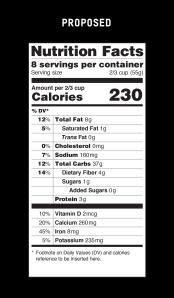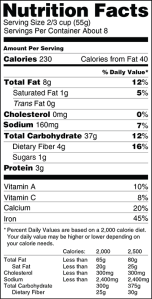Blog Archives
First Look at Changes for New Nutrition Labels
The FDA made it its goal earlier this year, previous post Changes to Out Date Nutrition Labels, to update the 20 year old nutrition facts panel. The Nutrition Facts label was introduced in 1993 and since then the American diet has immensely changed. As the rates of obesity, as well as other public health problems, rise to drastic highs many have blamed the food products we consume. Michele Obama has been one of the leading voices for making a healthier America with the “Let’s Move” initiative.
What will the changes look like? Michael Landa said, “The proposed new label is intended to bring attention to calories and serving sizes, which are important in addressing these problems. Further, we are now proposing to require the listing of added sugars. The 2010 Dietary Guidelines for Americans recommends reducing calories from added sugars and solid fats,” director of the FDA’s Center for Food Safety and Applied Nutrition.
What will be different? Proposed vs old.
- emphasis and bold in some areas like calories & serving size
- no more calories from fat
- update Daily Values
- amount of potassium & Vitamin D will be required
- update serving size to reflect what is typically eaten
- & more
This proposal has not entered a 90 day public waiting period for comments. After the 90-day comment period, the FDA will issue a final ruling. They hope to complete that process within a year. Manufacturers will have 2 years to get the new labels on packages.
Changes To Out Of Date Nutrition Labels
 The use of nutrition labels has changed over the past twenty years, where as the products that they are posted on have drastically changed forms. It wasn’t until 1990 that food producers were required on most prepared and packaged food. Much more prepared packaged food has been lining the shelves of grocery stores. Notably over the past few years consumers have become more vested in what exactly they are putting into their bodies. A study done by the U.S. Department of Agriculture showed a sinificant rise in the percentage of working-age adults who look at labels either most of the time or always when shopping, up from 34% in 2007 to 42% as well as from 51% of Americans older than 68 to 57%.
The use of nutrition labels has changed over the past twenty years, where as the products that they are posted on have drastically changed forms. It wasn’t until 1990 that food producers were required on most prepared and packaged food. Much more prepared packaged food has been lining the shelves of grocery stores. Notably over the past few years consumers have become more vested in what exactly they are putting into their bodies. A study done by the U.S. Department of Agriculture showed a sinificant rise in the percentage of working-age adults who look at labels either most of the time or always when shopping, up from 34% in 2007 to 42% as well as from 51% of Americans older than 68 to 57%.
The Food and Drug Association has announced that it will be updating nutrition labels, though any specific details are unknown at this time. The FDA said that knowledge about nutrition has evolved over the last 20 years, and the labels need to reflect that. Guidelines have been sent to the White House but it is unknown when they might been released. Michael Taylor, the FDA’s deputy commissioner for foods, said the FDA has been working on this issue for a decade.
A few popular suggested changes by health advocates include
Emphasize calorie counts
Put added sugar on its own line
clearer definition of serving size
added percentage of whole wheat
clearer measurements, getting rid of grams
It is not clear what changes the FDA could decide on but it is clear that changes needed to be made. Hopefully changes will be made as soon as possible so consumers can become more knowledgeable about what type of products they are consuming.


